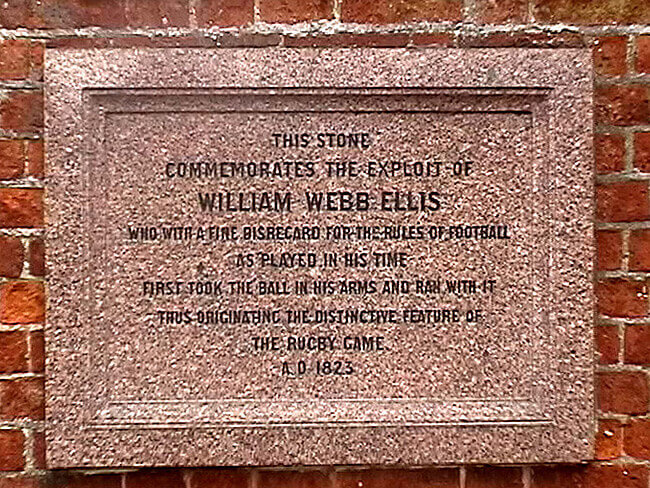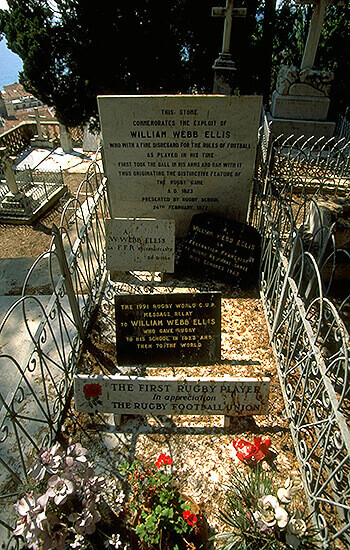William Webb Ellis, stand up, boy
A match will be played at Twickenham on 31 October 2015 and the winner will, with much glee, be awarded rugby's World Cup.
The prize is The Webb Ellis Cup. That is the name inscribed on handsome trophy.
We look at the man behind the name.
Why Webb Ellis?
There is a story that on the Close at Rugby School in Rugby, Warwickshire, a game of soccer was in progress in 1823.
Suddenly, in a flash of inspiration, a boy, William Webb Ellis, picked up the ball and ran with it. Alleluia, all exclaimed, that's the way we want to play, and rugby football was born.
This has, literally, been cast in stone, on a tablet let into a wall next to the field: THIS STONE COMMEMORATES THE EXPLOIT OF WILLIAM WEBB ELLIS WHO, WITH A FINE DISREGARD FOR THE RULES OF FOOTBALL AS PLAYED IN HIS TIME, FIRST TOOK THE BALL IN HIS ARMS AND RAN WITH IT, THUS ORIGINATING THE DISTINCTIVE FEATURE OF THE RUGBY GAME. AD 1823
There is a book's worth of debate about this.
Just a couple of things.
There was no game called soccer in 1823. The stone was put in place in 1895 and the inspiration for the story was not even there as he had died 23 years before!
Rugby league came into being in 1895.
Any rate, who was William Webb Ellis?
It's a good question, because in fact little is known of him and people may even be getting his name wrong.
His father was James Ellis, who married Miss Ann Webb at St Peter's Church in Exeter in 1804. They had two sons, Thomas and William. William was not yet six years of age when his father was killed.
On 1 November 1804 James Ellis was commissioned in the 18th Regiment of Foot. On 11 April 1805 he became an ensign in the 7th (Princess Royal's) Dragoon Guards, a cavalry regiment. In 1807 he was an ensign, stationed at Dundalk, Clonmel and Dublin in 1807. On 14 September 1809 he bought, for £735, a commission in the 3rd (Prince of Wales's) Dragoon Guards and was killed at the bloody Battle of Albuera on 16 May 1812, during the Peninsula War. Albuera is about 20 km from Badajoz.
Mrs Ellis, with an army pension of £10 per annum for each child and without other means, moved to Rugby, possibly because she had relatives there, possibly to see to her children's education as residence in Rugby made her sons eligible to be foundationers at Rugby School, founded by Lawrence Sheriff in 1567 and on its present site since 1750. To qualify as a foundationer the pupil had to live within a radius of 10 miles of the Rugby Clock Tower.
When the brothers Thomas and William entered Rugby School they were day boys and in reality charity cases. This is important for it is hard to imagine that the actions of a day boy could have any momentous results.
The name? His father's surname was Ellis. There was no Webb in his name. The mother's surname was Webb. William was called William Webb Ellis. There is no hyphen. He himself signed his name W.W. Ellis. It would seem that the family had no intention of creating a double-barrelled name as they named their first son (born in December 1804) simply Thomas Ellis – no other names and certainly no Webb. The family obviously did not intend that he be Webb Ellis and he did not use it as a surname.
It would seem that Ellis was his surname and the Webb Ellis bit may have been to add a bit of posh. Matthew Bloxham who did the investigation into the origins of the rugby game which resulted in the tablet quoted above referred to him as Mr Ellis.
Thomas Ellis was baptised in St Martin's in the Field, London, which suggests that he may have been born in London. William gave his birthplace as Manchester, though he is unlikely to have remembered the exact location. It is sometimes given as Salford, though the distinction between the two cities is vague. Sometimes his birthplace is given as Dundalk. He was baptised in Trinity Church, Salford, on 2 January 1807. It is unlikely that a child of under two months would have crossed the Irish Sea.
William Webb Ellis entered Rugby School in September 1816. He left it in 1825. In 1823 when he is supposed to have picked up the ball and ran with it, he was fairly high up the school which was suffering an unsuccessful period in its history under the headmastership of Dr J Wooll. When Ellis first entered Rugby School there were 380 boys in the school. When Dr Wooll left there were 143. The school did not pick up till Dr Thomas Arnold, one of the most famous headmasters in British public school history, took over in 1828. It was Arnold who would set it in the way to producing muscular Christians capable of ruling an empire and using sport as a means to his end. It was in Arnold's time that the rules of football as played at Rugby School became more popular than those at other schools such as Winchester and Eton. Arnold's reign at Rugby School started after Ellis had left the school.
For Part Two, CLICK HERE!
By Paul Dobson
@rugby365com




















































